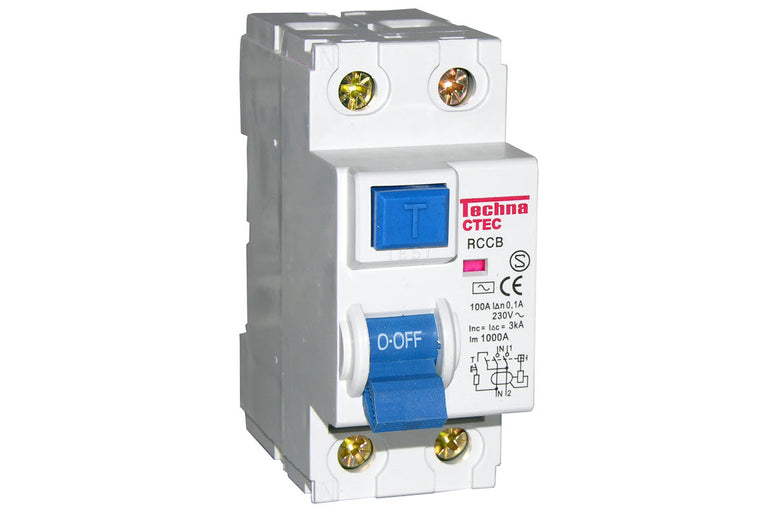Are Lighting Circuits Protected by RCD?

While lighting may seem pretty straightforward, there are several elements working behind the scenes to get the result of a standard fixture. When it comes to circuits and RCD protection, you may have a few questions. Here’s what you need to know about this topic for your home or business.
What is an RCD?
Residual current devices (RCD) is a safety switch intended to protect humans from electrical currents or shocks. Since electrocution can be deadly, it is an essential component of almost any light solutions. However, it is important to note that safety practices must be in place, and this device is not a guarantee of protection against shocks. It should also be made clear that many times people will ensure these devices are installed in their lighting solutions, yet fail to routinely check if they are still operational. An RCD is only as effective as it is functional so regularly check them for failure or damage.
How does it work?
An RCD works by detecting leaks in electrical currents which may pose a risk of shock. For example, electrical currents are intended to travel through selected conduits for safe electrical power, and when there is a leak in that conduit, electrical power can be placed where it causes a shock hazard to people. The RCD works by detecting those leaks and then disconnecting the power source of the electrical current to reduce the risk. While some shocks may still occur, the RCD greatly reduces the intensity of the shock if one is felt.
Are lighting circuits protected by RCD?
Another question many people have about this aspect of lighting is whether or not it protects the circuit of a light solution. While an RCD will not prevent a blown circuit, it will certainly alert you to an issue with the circuitry overall. If a lighting solution is constantly using the RCD and shutting off power to protect humans from getting shocked, there is already a problem with your circuitry of the fixture. Many people think a circuit issue is a lack of power, but in reality, most of the time it is caused by excessive electrical currents traveling outside of the acceptable conduits of the solution.
 High Bay LED Lighting
High Bay LED Lighting
 Industrial Low Bay Lighting
Industrial Low Bay Lighting
 Industrial Strip Lights
Industrial Strip Lights
 Vapor Tight Lighting
Vapor Tight Lighting
 LED Shop Lights
LED Shop Lights
 Hazardous Area / Explosion Proof Lighting
Hazardous Area / Explosion Proof Lighting
 Loading Dock Lights
Loading Dock Lights
 Construction / Portable Lighting
Construction / Portable Lighting
 Industrial Ceiling Fans
Industrial Ceiling Fans
 LED Work Lights
LED Work Lights
 Clearance
Clearance
 Troffer Lights
Troffer Lights
 LED Flat Panel Lights
LED Flat Panel Lights
 Drop Ceiling Lights
Drop Ceiling Lights
 Suspended LED Lights
Suspended LED Lights
 Exit / Emergency
Exit / Emergency
 Wrap Lighting Fixtures
Wrap Lighting Fixtures
 Gooseneck and Barn Lights
Gooseneck and Barn Lights
 Commercial Stairway Lighting
Commercial Stairway Lighting
 Hospital Bed Lights
Hospital Bed Lights
 Commercial Sign Lights
Commercial Sign Lights
 UV Disinfecting Lights & Air Purifier Fixtures
UV Disinfecting Lights & Air Purifier Fixtures
 Recessed Lighting
Recessed Lighting
 Wafer Lighting
Wafer Lighting
 RGB LED Lights
RGB LED Lights
 Grow Lights
Grow Lights
 Refrigeration Lighting
Refrigeration Lighting
 LED Flood Lights
LED Flood Lights
 Outdoor Wall Lights
Outdoor Wall Lights
 LED Area Lights
LED Area Lights
 Parking Lot Lights & Poles
Parking Lot Lights & Poles
 Outdoor Post Top Lights
Outdoor Post Top Lights
 LED Stadium Lighting
LED Stadium Lighting
 Canopy Lights
Canopy Lights
 Security Lights
Security Lights
 LED Bollard Lights
LED Bollard Lights
 Solar Powered LED Lighting
Solar Powered LED Lighting
 Dusk to Dawn Lights
Dusk to Dawn Lights
 Landscape Lighting
Landscape Lighting
 Outdoor String Lights
Outdoor String Lights
 Coastal Wildlife Lighting
Coastal Wildlife Lighting
 Outdoor House Lights
Outdoor House Lights
 Ceiling Fans
Ceiling Fans
 Ceiling Lights
Ceiling Lights
 Chandelier Lights
Chandelier Lights
 Pendant Lighting
Pendant Lighting
 Island Lights
Island Lights
 Track Lighting
Track Lighting
 Under Cabinet Lighting
Under Cabinet Lighting
 Vanity Lights
Vanity Lights
 Wall Sconces
Wall Sconces
 LED Tape Lights
LED Tape Lights
 LED Light Bulbs
LED Light Bulbs
 LED Tube Lights
LED Tube Lights
 LED Corn Lights
LED Corn Lights
 Vintage LED Bulbs
Vintage LED Bulbs
 Decorative LED Bulbs
Decorative LED Bulbs
 Fluorescent Light Bulbs
Fluorescent Light Bulbs
 Metal Halide Lamps
Metal Halide Lamps
 Shatterproof Light Bulbs
Shatterproof Light Bulbs
 LED Magnetic Strip Retrofit Kits
LED Magnetic Strip Retrofit Kits
 LED Strip Light Retrofit Kits
LED Strip Light Retrofit Kits
 High Bay LED Retrofit Kits
High Bay LED Retrofit Kits
 LED Troffer Retrofit Kits
LED Troffer Retrofit Kits
 LED Wall Pack Retrofit
LED Wall Pack Retrofit
 LED Street Light Retrofit Kits
LED Street Light Retrofit Kits
 Recessed Lighting LED Retrofit Kits
Recessed Lighting LED Retrofit Kits
 CFL Ballasts
CFL Ballasts
 Electronic Halide Ballast
Electronic Halide Ballast
 Emergency Ballasts & Inverters
Emergency Ballasts & Inverters
 Fluorescent Ballasts
Fluorescent Ballasts
 LED Drivers
LED Drivers
 High Pressure Sodium Ballasts
High Pressure Sodium Ballasts
 Metal Halide (HID) Ballasts
Metal Halide (HID) Ballasts
 Pulse Start Metal Halide Ballasts
Pulse Start Metal Halide Ballasts
 Electric Vehicle Chargers
Electric Vehicle Chargers
 Ballasts & Drivers
Ballasts & Drivers
 Electrical Supplies
Electrical Supplies
 Electrical Tools
Electrical Tools
 Switches & Receptacles
Switches & Receptacles
 Hand Dryers
Hand Dryers
 Electrical Power Cords
Electrical Power Cords
 Sensors and Timers
Sensors and Timers
 Smart Home Automation
Smart Home Automation
 High Bay Occupancy Sensors
High Bay Occupancy Sensors
 Outdoor Motion Sensor Lights
Outdoor Motion Sensor Lights
 Walkway Lights
Walkway Lights
 Office Lights
Office Lights
 Gym Lighting
Gym Lighting
 Exterior Building Lights
Exterior Building Lights
 Sports Lighting
Sports Lighting
 Hospital Lights
Hospital Lights
 Airport Lights
Airport Lights
 Classroom Lights
Classroom Lights
 Factory Lights
Factory Lights
 Restaurant Lights
Restaurant Lights
 Corridor Lights
Corridor Lights
 Church Lights
Church Lights




